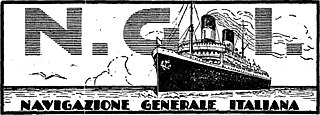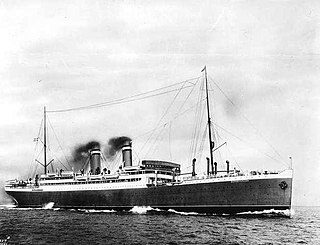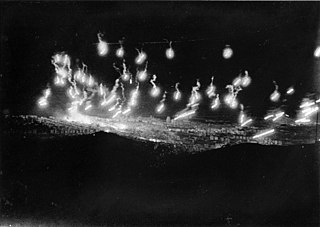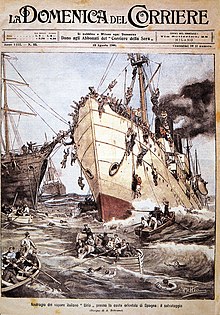
Costa Crociere S.p.A., operating as Costa Cruises, is an Italian cruise line founded in 1948 and organized as a wholly owned subsidiary of Carnival Corporation & plc since 2000. Based in Genoa, Italy, the cruise line primarily caters to the Italian cruise market, but the company's 10 ships, which all sail under the Italian flag, provide itineraries sailing to countries globally.

The Northfleet was a British full-rigged ship that is best remembered for her disastrous sinking in the English Channel in January 1873.
Giorgio Bàrberi Squarotti was an Italian academic, literary critic and poet. He taught at the University of Turin from 1967 until his death in 2017. He was considered to be one of the most important literary critics of his time.

Navigazione Generale Italiana (NGI) was an Italian shipping company.

Renato Chiantoni was an Italian actor. He appeared in 100 films between 1937 and 1978.

SS Bergensfjord was a Norwegian ocean liner that sailed for the Norwegian America Line to the United States. During the Second World War she was requisitioned by the British Ministry of War Transport and used as a troop ship. After the war she continued sailing as a Trans-Atlantic passenger liner, first for South American owners, then for an Israeli company.
Pietro Querini was a 15th-century sailing captain from the Republic of Venice. He is known for being shipwrecked at Røst in northern Norway during the winter of 1432, and subsequently returning to Venice, where he wrote a report of his travels for the senate. He is also credited with popularizing Stockfish in the Veneto region, where it is prepared as Baccalà alla vicentina.

SS Utopia was a transatlantic passenger steamship built in 1874 by Robert Duncan & Co of Glasgow. From 1874 to 1882 she operated on Anchor Line routes from Glasgow to New York City, from Glasgow to Bombay and from London to New York City. After 1882 she carried Italian immigrants to the United States.

The SSPrincipessa Mafalda was an Italian transatlantic ocean liner built for the Navigazione Generale Italiana (NGI) company. Named after Princess Mafalda of Savoy, second daughter of King Victor Emmanuel III, the ship was completed and entered NGI's South American service between Genoa and Buenos Aires in 1909. Her sister ship SS Principessa Jolanda (1907) had sunk immediately upon launching on 22 September 1907.

Don Andrea Gallo was an Italian presbyter, founder and leader of the community of San Benedetto al Porto of Genoa. He often called himself a "priest of the sidewalk", referring to his activity of helping poor and needy people.
My gospels are not four... We have been following for years and years the gospel according to De André, a path that is in obstinate and contrary direction. And we can confirm it, note it: from diamonds nothing was born, from dung flowers bloom.

Anna Maria Ortese was an Italian author of novels, short stories, poetry, and travel writing. Born in Rome, she grew up between southern Italy and Tripoli, with her formal education ending at age thirteen. Her first book, Angelici dolori, was issued in 1937. In 1953 her third collection, Il mare non bagna Napoli, won the coveted Viareggio Prize; thereafter, Ortese's stories, novels, and journalism received many of the most distinguished Italian literary awards, including the Strega and the Fiuggi. Although she lived for many years in Naples following the Second World War, she also resided in Milan, in Rome, and for most of the last twenty years of her life in Rapallo. L'iguana, Ortese’s best known work in English translation, was published in 1987 as The Iguana by the American literary press McPherson & Company. As of 2023, what she considered as her most important work, the novel Il porto di Toledo (1975), had not been translated into English yet.
The steamer SS Ercolano was a passenger steamship which plied the waters of the Mediterranean in the 1850s.

Genoa is a city in and the capital of the Italian region of Liguria, and the sixth-largest city in Italy. In 2023, 558,745 people lived within the city's administrative limits. While its metropolitan area has 813,626 inhabitants, more than 1.5 million people live in the wider metropolitan area stretching along the Italian Riviera.

Ansgar Vonier, engl. Anscar Vonier, O.S.B., was an Abbot of Buckfast Abbey (1906–1938).
SS Chester was a passenger and cargo vessel built for the Manchester, Sheffield and Lincolnshire Railway in 1884.
Lamberto Loria was an Italian ethnographer, naturalist and explorer.

Owing to the importance of its port and industries, the Italian port city of Genoa, the regional capital and largest city of Liguria, was heavily bombarded by both Allied air and naval forces during Second World War, suffering heavy damage.
The battle of Rapallo was a naval battle fought on 2 May 1495, during the First Italian War, between a fleet of the Republic of Genoa under the command of Francesco Spinola and a French fleet under the command of Louis de Miolans.

MS Orazio was an Italian ocean liner of the interwar period, owned by Navigazione Generale Italiana and later the Italian Line. She was destroyed by a fire off Toulon in January 1940, with the loss of 108 lives; in terms of loss of life this is the fourth worst peacetime maritime disaster in Italian history, after those of Principessa Mafalda, Sirio, and Moby Prince. It was however quickly forgotten due to Italy entering World War II a few months later.
















